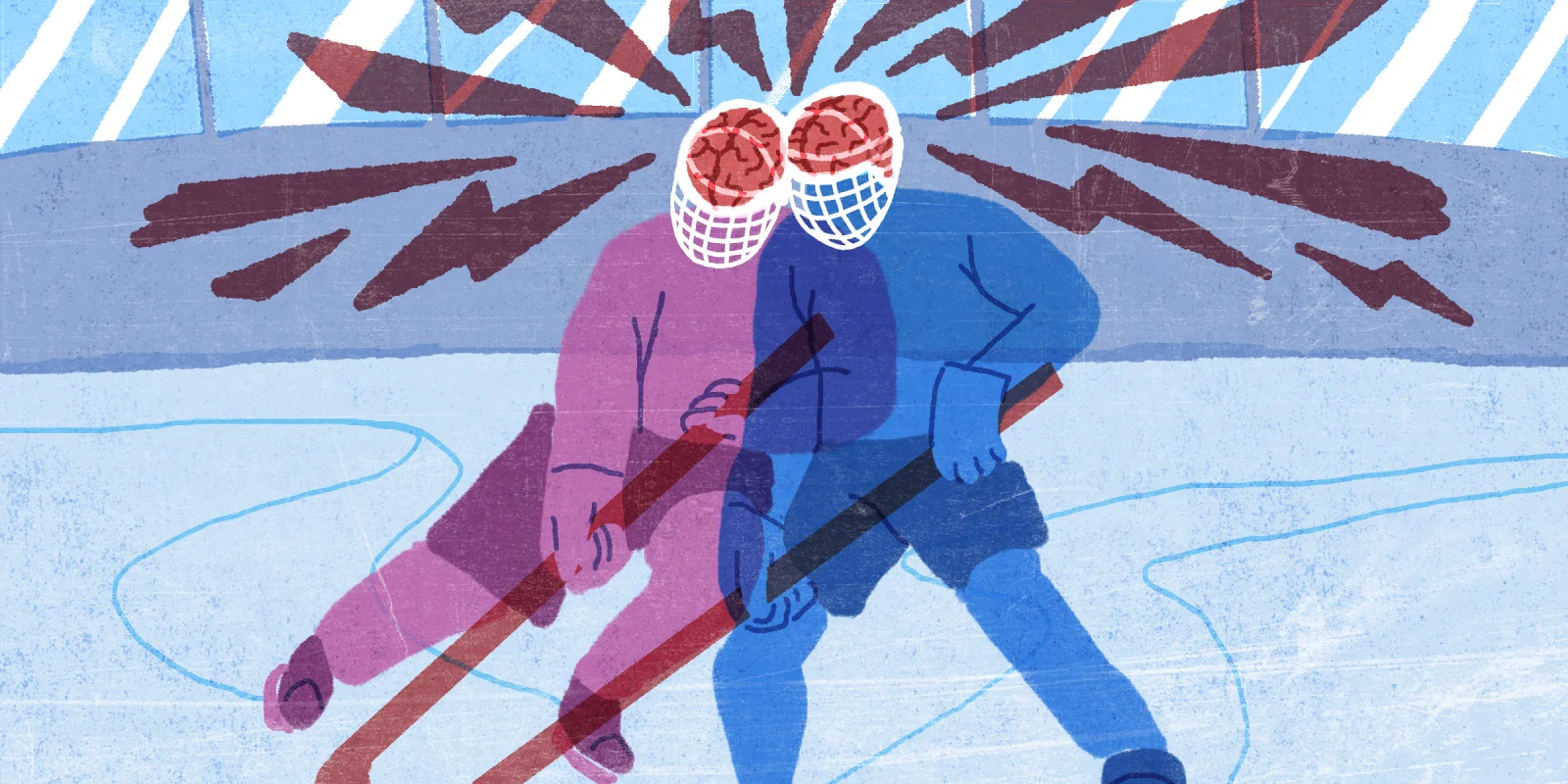“How many fingers do you see?”
“Two,” I said. The question seemed too simple. But what did I know? I had as much medical knowledge as any other 8-year-old. Who was I to question the doctor?
Minutes before that, I was on the ice, racing another player to control a loose puck. But ice hockey is a game of split-second changes. Bodies collide at speeds exceeding 20 mph, balanced on steel blades less than 4 mm thick. Every shift, a player dances on the razor’s edge, and I slipped. I crashed, headfirst, into the boards.
“Do you have a headache?” he asked. He was my teammate’s father and an EM physician. My father stood in silence, leaning forward with an intent stare.
“Kind of, but not really,” I said. But the answer was yes, without a doubt. My forehead and temples throbbed, I felt dizzy, and I couldn’t remember what happened. From when I lost my footing, to when I looked up at the arena ceiling while coaches helped me off the ice, there was nothing.
“It was so loud. It sounded like thunder,” my father said.
I can’t remember the score now. Or who we played against. Or what was at stake. But I wanted to keep playing. So I said what I needed to say.
Fortunately, neurosurgery residency (and another 20 years of life experience) changed my priorities. I’m no longer inclined to intentionally ignore the symptoms of a concussion, as I did when I crashed into the boards that day. But, in a twist of irony, this epiphany can be difficult to apply. More severe brain injuries present with a litany of red flags, including stories of high-speed, unrestrained auto accidents, and CT scans littered with fractures and contusions. Concussions, however, are devious in their subtlety. Presenting symptoms and methods of rehabilitation vary between subtypes, and many classic symptoms are inherently subjective. If a spirited child suffers a minor head trauma and has “difficulty concentrating” in school, is this a result of the head trauma? Perhaps he’d just rather be outside. Or playing hockey. We’ll never be certain, because we cannot feel their headaches. When they are “seeing stars,” we do not see them. When the room spins around them, we are still. As such, return-to-play guidelines vary, and each brain-injured athlete endures a unique recovery.
Many sports carry the risk of head trauma, and newer rule changes for younger players may provide some protection (the U.S. Soccer Federation recently imposed limitations on heading the ball for players younger than 14). But in hockey, enduring head trauma is more than a coincidental byproduct of gameplay. It is a symbol of valor. Missing teeth reflect heart and sacrifice. Fans stand and cheer when players “drop the gloves” and engage in bare-knuckle fights. “Enforcers” or “goons” are designated fighters. They may only play two minutes in a game. Their job is not to score goals, or to defend, but to even the score after a dirty play. When a player falls to his knees during a fight, and covers his head to avoid contact, he is “turtling.” It’s a coward’s move. When Rodney Dangerfield quipped, “I went to a fight the other night, and a hockey game broke out,” he gave eloquent confirmation that violence is the marrow of hockey’s history.
With a value system so clear, it’s no wonder that younger players push themselves to play through signs of a concussion. The number of head injuries I saw during my undistinguished youth hockey career rivals that of my residency. Elbows to the head leading to dizziness and instability on skates. Complaints of headaches in the locker room between periods. One of my high school teammates endured a collision so rattling that, when he attempted to stand, he immediately collapsed. He stood again, skated nearly 10 feet in the wrong direction, and collapsed again. He took a 15 minute break, then finished the practice.
As devastating as the initial head impact can be, what may be more concerning is the long-term impact of these injuries. Research on chronic traumatic encephalopathy (CTE) pervades recent news cycles, and the list of deceased professional hockey players diagnosed with CTE continues to grow. But these men were paid millions of dollars to play the sport, and to place themselves at risk. They had agents, signed contracts, and in many cases, they had access to some of the finest available medical care. But what happens to players who never make it that far? The evidence is sparse, but not encouraging. Post-mortem analysis of the brains of teenage collision sport athletes has shown early evidence of CTE, and childhood TBI may confer greater risk of substance abuse disorder in adulthood.
Can we afford this risk? How can we minimize it?
The medical field cannot wait for other people to solve this problem. Ice hockey and other contact sports will remain captivating, beautiful, and violent. Our youngest players, emboldened by unbridled love of the sport and dreams of fame and fortune, will continue to subject their brains to premature punishment. Overzealous parents and coaches, driven by competitive impulse, will push them to play. But we are not bound by these constraints. Our knowledge and training protect those who cannot protect themselves. And this includes child athletes.
The physician who examined me was not on call when I crashed into the boards headfirst 20 years ago. He came to the rink to watch his son play hockey, but his sense of duty compelled him to go to work for my safety. I feel the same responsibility today. If we celebrate hockey’s glorification of brain injuries and dismiss the potential consequences of youth concussions, we delay progress in an epidemic that should not remain silent.
As a clinician, do you approve of the sports you played as a child? Share your childhood sports in the comments.
James Caruso is a neurosurgery resident at UT Southwestern Medical Center in Dallas, TX. He plans to specialize in complex spine surgery, and his research focuses on elucidating the molecular mechanisms driving chronic neck and back pain. He is a 2021-2022 Doximity Op-Med Fellow.
Illustration by Diana Connolly







